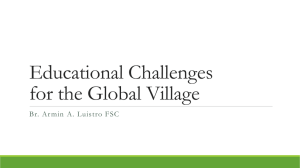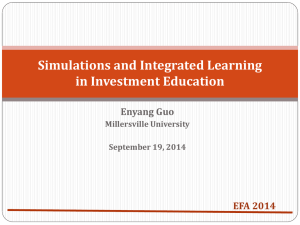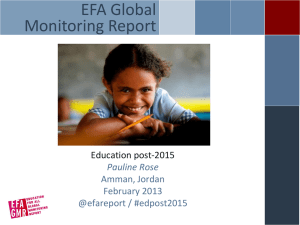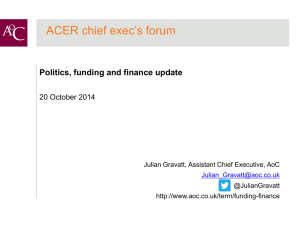Progress towards the EFA goals
advertisement
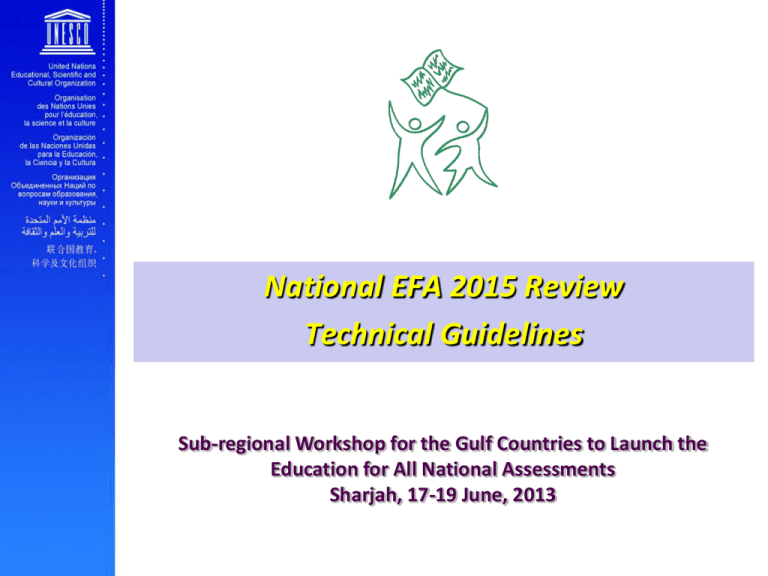
National EFA 2015 Review Technical Guidelines Sub-regional Workshop for the Gulf Countries to Launch the Education for All National Assessments Sharjah, 17-19 June, 2013 Objectives • Contents – what does the guidelines says • Process – How a national report will be prepared • Clarification – going into details 2 What will be assessed/reviewed? Renewal of collective commitment International Education Agenda (beyond 2015) Nation Education Agenda (beyond 2015) Assessing progress towards the six EFA goals Effectiveness Relevance of the EFA framework Relevance Reviewing implementation of strategies in achieving EFA Efficiency 3 Technical guidelines for EFA Assessment 4 EFA 2015 Reviews - Technical guidelines • Specific to country authorities stakeholders to document and • progress achieved towards the EFA goals • experiences in implementing the EFA strategies • lessons learnt, emerging issues and challenges EFA to inform public debates on the future education agenda for the post-2015 era. 5 EFA 2015 Reviews vs. other previous EFA assessments EFA 2015 Reviews Evaluation Other previous EFA Assessments Monitoring/ Assessing How and what has been achieved Setting a new agenda What can we bring to future What has been achieved so far Progress made so far What still need to be done Collective work of all EFA Stakeholders and country led 6 Scope of National EFA 2015 Review Assessing progress towards the six EFA goals 6 EFA Goals National Education Development Goals/ Targets What have been achieved? Reviewing implementation of strategies in achieving EFA 12 Implementation Strategies National Education Development Strategies and Programmes How have been achieved? Determining the relevance of EFA framework EFA and National Development Post-2015 National Education Agenda What can be learned? Assessing progress towards 6 EFA goals What has been achieved with respect to each of the six EFA goals and related national education development goals and targets using: Quantitative indicators can be derived using existing data from administrative education statistics/EMIS, population censuses, household surveys and other reliable data sources. (see Annex 4) Qualitative analyses based on policy documents and the findings from in-country research reports and case studies in relation to the guiding questions. (see Annex 5) Maximum use should be made of disaggregated data to identify differences, disparities, gaps, remaining challenges, disadvantaged geographical areas and population groups, and future priorities within the country. If needed and possible, additional data collection, sample testassessment of learning outcomes applying internationally-accepted methodology, as well as specific thematic research can be conducted to supplement and enrich the review report. 8 Reviewing the implementation of 12 EFA strategies How has progress towards the EFA goals been achieved? How the country implemented the 12 Dakar strategies in relation to national education strategies, policies, plans and programmes. Highlight some good practices, key factors of success, lesson learnt, plus how best to use these experiences to work effectively on attaining each EFA goal in the future. Importance of the country’s financial commitment to EFA. Partnerships for EFA with other government ministries/ agencies, civil society organizations, local communities, international development partners, etc. Specific national strategies, policies, programmes and practices which contributed toward achieving the EFA goals. 9 Relevance of existing EFA framework and the future education agenda How relevant has the EFA framework been within the national development framework With respect to priority needs and targets within the country, major national education development strategies, policies and plans, implementation mechanisms and capacities, outcomes and impact Shaping the country’s future education agenda and regional and global post-2015 education agenda generating public debate on the country’s education agenda after 2015. National EFA 2015 Review processes to help to raise public attention and more in-depth elaboration of future education priorities and strategies. 10 Suggested content and outline of National EFA 2015 Review Reports Section 1: Introduction Section 2: Main EFA challenges in 2000 and targets for 2015 Section 3: Progress towards the EFA goals 3.1 Expanding ECCE(Early Childhood Care and Education) 3.2 Universalizing primary/basic education 3.3 Meeting the learning needs of youths and adults 3.4 Improving adult literacy level 3.5 Gender parity and equality in education 3.6 Quality of education Section 4: Implementation of EFA strategies Section 5: Relevance of the EFA framework Section 6: Prospects for post-2015 Annexes: Major references; detailed statistical tables; excerpts from policies/plans; etc. 11 Suggested content and outline of National EFA 2015 Review Reports SUGGESTED STRUCTURE MAIN CONTENTS - Description of the country's context and commitment to EFA - National strategies, policies, plans and targets for education Section 1: Introduction - Institutions responsible for implementing EFA and coordination mechanism - Partnerships with other ministries, agencies, civil society organizations, and international development partners - Overall EFA situation and challenges in 2000 Section 2: Main EFA challenges - National targets for 2015 (ref. National EFA Action Plan) in 2000 and targets for 2015 - Challenges for achieving each EFA goal and strategy Section 3: Progress towards the - Overall EFA achievements and shortfalls EFA goals 3.1 Expanding ECCE(Early - Progress made in EFA Goal 1 and remaining challenges Childhood Care and Education) 3.2 Universalization of - Progress made in EFA Goal 2 and remaining challenges primary/basic education 3.3 Meeting the learning - Progress made in EFA Goal 3 and remaining challenges needs of youths and adults 3.4 Improving adult literacy - Progress made in EFA Goal 4 and remaining challenges level 3.5 Gender parity and - Progress made in EFA Goal 5 and remaining challenges equality in education 3.6 Quality of education - Progress made in EFA Goal 6 and remaining challenges 12 Suggested content and outline of National EFA 2015 Review Reports SUGGESTED STRUCTURE MAIN CONTENTS - How effectively were the 12 strategies implemented? - What were the constraints and solutions? Section 4: Implementation - What education reforms in the country have been influenced by EFA (e.g. free primary of EFA strategies education)? - What have been the experiences in implementing such reform? What were the results? - In what way was the EFA framework relevant (or can be more relevant) to the country? Section 5: Relevance of the - How has the EFA framework contributed to education development in the country? EFA framework - What were the factors and in what way have they affected EFA implementation in the country? Section 6: Prospects for post-2015 - Overall lessons learnt with regard to EFA since 2000 - Main lessons learnt with regard to each EFA goal and implemented strategies - Emerging issues, shortfalls/what remains to be done, priorities and strategies in future national education agenda - Prospects for education in the country beyond 2015 Annexes: - Major references - Glossary of terms used - Detailed statistical tables - Excerpts from policies/plans; etc. 13 National EFA 2015 Review processes and preparation of national report • National EFA 2015 Review Team • National EFA Coordination Committee • Government departments/agencies at both central/federal • • • and decentralized levels which oversee respectively: education policies and planning, early childhood care and education, basic education, adult education, literacy and skills training, teachers and teacher training, teacher unions, inspectorate, finance, etc. National Education Statistics/EMIS Unit National Statistics Office Civil society organizations representatives who have been actively supporting EFA Education researchers and experts in EFA • • to plan, organize, coordinate and implement the main review tasks and to prepare the National EFA 2015 Review Report. 14 Phase 1 of National EFA 2015 Review Check what data and indicators are available and where there are gaps and discrepancies Gather and review available EFA-related policy documents and reports, research papers and case studies Preliminary analysis and interpretation of presently available data and information to identify some of the latest achievements and shortfalls, issues, challenges as well as priority actions to accelerate EFA during 2013-2015 Where needed and possible, additional data collection, test-assessments of learning outcomes, and/or research studies may be planned 15 Phases 2 and 3 of National EFA 2015 Review Phase 2: Design and propose a work plan for the National EFA 2015 Review for support by the government and development partners Define the scale of work, activities, teamwork and division of responsibilities and labour, work assignments, expected outputs, and timeline within each country Phase 3: Carry out more in-depth review tasks pertaining to specific EFA goals, strategies or themes Task Groups composed of competent bodies or experts Analysing and interpreting EFA-related data and indicators Reviewing policies, plans, strategies, reports and research studies to extract salient elements Compiling the National EFA 2015 Review Report and organize consultations 16 Important elements of the Technical Guidelines Annex 4: Suggested indicators by EFA Goals Annex 5: Suggested guiding questions by EFA Goals and themes Annex 6: References – Further references and additional resources 17 Final words • This is not the end of the story telling, it is the writing of the beginning of a new chapter. • Learning from the past is a gift for the future. • Those neglects learning in his/her past, loses the past and is dead for the future. • Moving on isn’t forgetting the past, its learning from it. Learning from the past, living in the present, preparing for the future. Meeting Our Collective Commitments For the country, by the country Thank you Q& A

